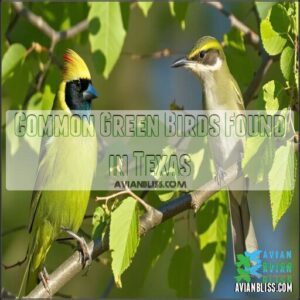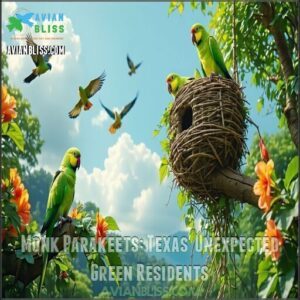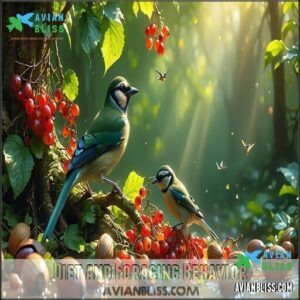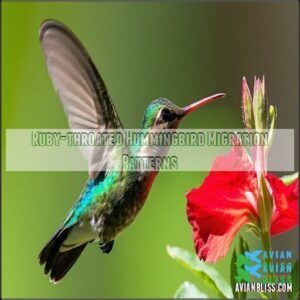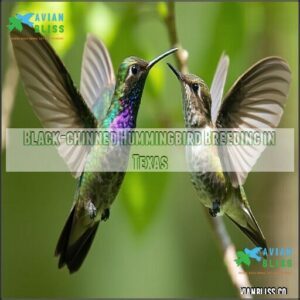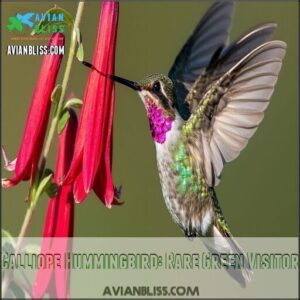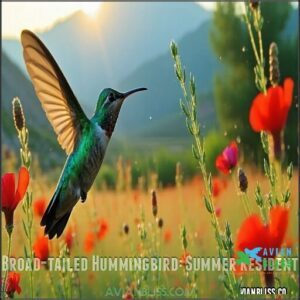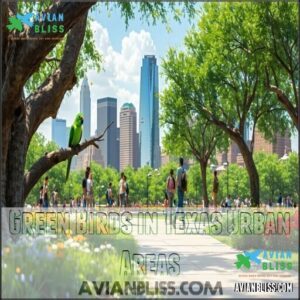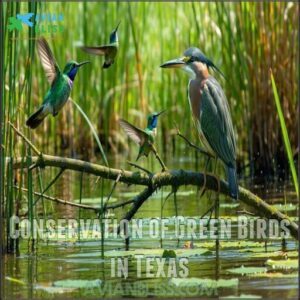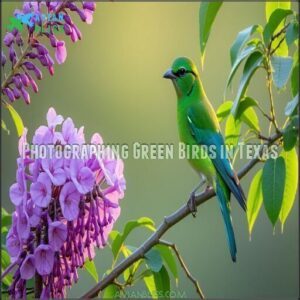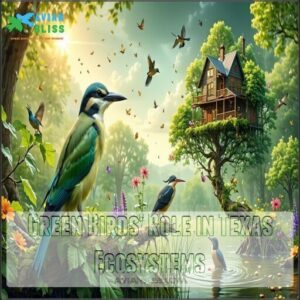This site is supported by our readers. We may earn a commission, at no cost to you, if you purchase through links.
 You’ll spot several green birds in Texas if you know where to look.
You’ll spot several green birds in Texas if you know where to look.
The monk parakeet, an urban settler with bright emerald feathers, has made itself at home in cities like Houston and Dallas.
In South Texas, you can’t miss the stunning green jays with their blue and black accents—these tropical beauties are like flying jewels.
Green herons lurk near waterways, while ruby-throated hummingbirds zip through gardens statewide.
Even common birds like painted buntings show off green backs during certain seasons.
The right bird feeder might turn your backyard into a green bird hotspot without driving across the state.
Table Of Contents
- Key Takeaways
- Common Green Birds Found in Texas
- Monk Parakeets: Texas’ Unexpected Green Residents
- Green Jays: Vibrant Jewels of South Texas
- Hummingbirds: Texas’ Tiniest Green Visitors
- Warblers: Olive-Green Songbirds in Texas
- Green Birds in Texas Urban Areas
- Seasonal Green Bird Visitors to Texas
- Conservation of Green Birds in Texas
- Photographing Green Birds in Texas
- Green Birds’ Role in Texas Ecosystems
- Frequently Asked Questions (FAQs)
- What is the smallest green bird in Texas?
- What are some small birds in Texas?
- What are the most common backyard birds in Texas?
- What is the largest bird in Texas?
- What are the green birds in Texas called?
- How did monk parakeets get to Texas?
- What are green parakeets called?
- Are monk parakeets invasive?
- How did Monk Parakeets get to Texas?
- What bird is bright green?
- Conclusion
Key Takeaways
- You’ll find diverse green birds across Texas, including Monk Parakeets in urban areas, Green Jays in South Texas, Ruby-throated Hummingbirds statewide, and various olive-green warblers during migration seasons.
- You can attract green birds to your backyard by installing appropriate feeders, planting native flowering plants for hummingbirds, and providing water sources, especially during summer months.
- You’ll notice invasive Monk Parakeets have successfully adapted to Texas cities, building massive communal nests on power structures and maintaining year-round populations despite not being native.
- You’re directly helping conserve Texas green birds when you participate in citizen science projects that track population changes, reduce pesticide use in your garden, and protect natural habitats.
Common Green Birds Found in Texas
You’ll find at least twelve species of green birds in Texas, including resident monk parakeets in urban areas and the colorful green jays in the southern regions.
From wetland-dwelling green herons to tiny ruby-throated hummingbirds that visit your garden feeders, these feathered friends add splashes of emerald to the Texas landscape.
Monk Parakeets: Bright Green Invaders
In recent decades, you might’ve spotted bright green Monk Parakeets zipping through Texas skies.
These noisy, social birds aren’t native—they escaped from the pet trade in the 1970s and made themselves right at home.
These feral populations showcase fascinating behavior:
- Building massive stick nests on utility poles and cell towers
- Forming tight-knit, chatty colonies with complex social structures
- Adapting remarkably well to urban environments despite tropical origins
- Maintaining their vivid lime-green plumage year-round
While their invasive impact concerns some ecologists, many Texans enjoy these unexpected green visitors that add tropical flair to the Lone Star State.
Green Jays: Colorful Southern Texas Residents
A jewel-toned flash of color announces the Green Jay, the smart showstopper of south texas birds.
Found primarily in the Rio Grande Valley, these brilliant birds sport a mix of blue, green, and yellow plumage that makes texas birds identification a joy.
You’ll hear their distinctive "cheh-cheh-cheh" calls before you spot them.
What makes Green Jays special:
- Green Jay intelligence rivals other corvids—they even use tools and imitate hawk calls to clear feeders!
- Their social behavior centers around family flocks that hunt together in spiral patterns through trees.
- Their survival faces challenges from habitat loss in the Lower Rio Grande Valley.
- Conservation efforts focus on protecting their preferred dense woodland habitats.
These clever texas wildlife residents build well-concealed nests in thorny thickets, showing remarkable adaptation to their shrinking territory.
Green Herons: Wetland Dwellers
Have you ever spotted a Green Heron lurking in Texas wetlands? These secretive birds with dark green backs are master hunters among green bird species.
Their compact size and stealthy nature make these wetland dwellers challenging but rewarding to find in your backyard birds Texas adventures.
| Green Heron Facts | What This Means For You |
|---|---|
| Uses bait to catch fish | You’ll witness clever hunting techniques |
| Most active at dawn/dusk | Best viewing times for photographers |
| Prefers shallow water | Look near pond edges and marshes |
| Stands motionless before striking | Patience rewards bird watchers |
Ruby-throated Hummingbirds: Tiny Green Migrants
Ruby-throated Hummingbirds, the buzzing marvels of Texas skies, captivate birdwatchers with their brilliant green plumage. These small green birds weigh just 3 grams, yet complete remarkable migrations across the Gulf of Mexico each year.
Males showcase iridescent emerald backs and distinctive ruby throats during mating rituals, while females display more subtle green feathers.
You’ll spot these aerial acrobats from March through October, hovering at flowers or hummingbird feeders filled with sugar water—their preferred nectar sources. Their specialized flight adaptations allow them to fly backward and upside down!
For garden attraction, plant native trumpets like salvias and columbines. Despite their tiny size, these green birds in Texas maintain stable conservation status, though habitat protection remains important.
Monk Parakeets: Texas’ Unexpected Green Residents
You’ll spot these bright lime-green parakeets building massive stick nests on power poles and cell towers throughout Houston and Dallas.
These non-native birds, originally from South America, have made themselves right at home in Texas cities where they’ve established thriving colonies despite our occasional cold snaps, which is a notable feat for birds that have adapted to thriving colonies.
Origin and Spread in Texas
The bright green flocks you might spot around Texas cities weren’t always local residents.
Monk parakeets made their Initial Arrival in the Lone Star State during the 1970s when pet birds escaped captivity and established wild colonies.
These sociable green parakeets quickly adapted to urban environments, demonstrating impressive Habitat Expansion across Texas cities:
- First established strong colonies in Houston and Dallas, building massive stick nests on power infrastructure
- Gradually spread to Austin, San Antonio, and other urban centers as their population grew
- Now found year-round as permanent residents, unlike most invasive species that struggle with Texas weather extremes
Though technically an Invasive Impact species, many Texans have embraced these noisy, charming parrots as colorful additions to urban bird species communities, viewing them as a permanent resident with massive stick nests and a notable Initial Arrival that has led to a significant Habitat Expansion.
Physical Characteristics and Behavior
You’ll instantly recognize monk parakeets in Texas by their striking lime-green plumage that stands out against urban backdrops.
These social birds combine beauty with bold personalities, often announcing their presence with loud, chattering vocalizations before you even spot them.
Their distinctive features include:
- Bright emerald-green bodies with subtle blue-tinted wing feathers
- Sturdy, curved beaks perfectly designed for cracking seeds and nuts
- Swift, agile flight patterns as they navigate in tight-knit groups
- Expressive faces with intelligent eyes and playful demeanors
Watch for their animated feeding habits at bird feeders, where they’ll skillfully manipulate seeds with their feet. Their gregarious nature means they’re rarely alone—you’ll typically spot them in noisy flocks, adding vibrant green splashes to Texas skies.
Nesting Habits and Urban Adaptation
You’ll be amazed by monk parakeets’ impressive urban nesting skills.
These bright green birds in Texas don’t just build nests—they construct elaborate condominiums.
Using twigs, branches, and urban materials, they create apartment-style structures on power poles, cell towers, and stadium lights.
Their adaptive strategies have helped them thrive in Texas cities.
| Nest Feature | Urban Benefit | Breeding Success |
|---|---|---|
| Multi-chamber design | Protection from weather | Raises multiple broods |
| High locations | Safety from nest predators | Higher survival rates |
| Communal living | Shared warmth | Cooperative parenting |
These green architects maintain their nests year-round, constantly adding materials and repairs.
Unlike other birds that build seasonal nests, monk parakeets create permanent homes that can weigh up to 200 pounds.
Their remarkable bird adaptation to urban environments shows nature’s resilience in human-dominated landscapes.
Impact on Local Ecosystems
While monk parakeets settled into urban life, they’ve been quietly reshaping Texas ecosystems in ways you mightn’t expect.
These bright green birds create massive communal nests that double as wildlife apartments. Native birds, insects, and small mammals often find shelter in these sturdy structures, creating mini-ecosystems on utility poles and tall trees.
Their impact on green bird habitats extends beyond construction:
- Seed dispersal: As fruit-eaters, they spread plant seeds differently than native birds, potentially altering vegetation patterns
- Insect control: Each bird can eat hundreds of insects daily, affecting local bug populations
- Invasive impacts: They sometimes outcompete native species for food resources
These changes aren’t all bad news. Monk parakeets provide unexpected pollination services and can help control certain pests. You’re witnessing bird ecosystems adapting in real-time when you spot these noisy green residents.
Green Jays: Vibrant Jewels of South Texas
You’ll spot the bright green jays with blue heads only in southern Texas, where these smart birds use sticks as tools to find insects under tree bark.
These colorful birds, found primarily in the Rio Grande Valley, add a tropical touch to Texas with their vibrant green bodies and blue-yellow markings.
Range and Habitat in Texas
For nearly 30 years, Green Jays have claimed a specific range in Texas, primarily inhabiting the southernmost tip of the state.
You’ll find these vibrant birds exclusively in the Lower Rio Grande Valley, where they thrive in dense woodland edges, thorny scrublands, and riparian corridors.
Their range rarely extends beyond Starr, Hidalgo, Cameron, and Willacy counties, creating a limited viewing area for bird enthusiasts.
Climate effects and habitat loss from urban sprawl threaten their Texas distribution.
For the best viewing opportunities, visit Santa Ana National Wildlife Refuge or Bentsen-Rio Grande Valley State Park, where established populations offer reliable year-round sightings.
Distinctive Features and Coloration
While exploring their natural habitats in Texas, you’ll find that Green Jays showcase some of the most striking features among green birds in the state.
These vibrant jewels of South Texas display remarkable plumage iridescence that transforms as sunlight plays across their feathers. Their color variation is truly spectacular, with a palette that serves both beauty and function.
When you spot a Green Jay, you’ll notice:
- Brilliant blue-green crowns that catch the morning light
- Rich emerald backs that blend perfectly with foliage (excellent camouflage techniques)
- Bright yellow underparts creating striking contrast
- Black masks and throat patches framing their expressive faces
- Blue tail tips that flash like signals when they fly
Unlike some species, Green Jays show minimal sexual dimorphism—males and females share similar appearances. Juvenile plumage appears slightly duller with less defined patterns.
Their distinctive bird appearance makes them easy to identify even for beginners. Once you’ve seen their unique blend of colors, you’ll never mistake them for other green birds in Texas.
Breeding Patterns and Nest Construction
Green Jays, the master nest-builders of Texas, form loyal pairs that stay together across breeding seasons.
You’ll spot their intricate nests 5-15 feet high in thorny shrubs from March through August.
Both parents work together, weaving twigs, leaves, and plant fibers into dome-shaped homes lined with soft moss.
The female lays 2-5 eggs per clutch, which they incubate for about 18-20 days before welcoming their chicks to South Texas.
Diet and Foraging Behavior
Green jays are the versatile eaters among the vibrant jewels of Texas bird habitats.
You’ll spot these intelligent birds foraging in family groups, constantly communicating while searching for their next meal.
Their diverse menu includes:
- Nuts and seeds they crack open with specialized beaks during winter months
- Insects and larvae hunted methodically in citrus groves and woodland edges
- Berries and fruits gathered from native plants in riparian zones
- Small vertebrates including lizards, frogs, and occasionally bird eggs
Watch for their acrobatic foraging techniques as they hang upside down to reach hidden prey.
They’re not shy about visiting backyard feeders either—offering you front-row seats to their dining habits!
As omnivores, they exhibit diverse feeding strategies depending on habitat and season.
Hummingbirds: Texas’ Tiniest Green Visitors
You’ll find several species of green hummingbirds buzzing through Texas, including the Ruby-throated, Black-chinned, Calliope, and Broad-tailed varieties.
These tiny green flyers, weighing less than a penny, zip around gardens and wildflowers at speeds that’ll make your head spin as they drink nectar and help pollinate Texas plants.
Ruby-throated Hummingbird Migration Patterns
While Green Jays dazzle South Texas, Ruby-throated Hummingbirds amaze with their migration patterns. These emerald flyers reach Texas by late February, with males arriving first.
Flight routes follow the Gulf Coast, where nectar sources fuel their journey. Climate change affects migration triggers, shifting arrival times.
You’ll spot these green birds in Central Texas near Austin and Houston from March through May. Keep your feeders ready—they visit 1,000+ flowers daily during bird migration. Conservation efforts help these tiny travelers thrive, ensuring the conservation of these species.
Black-chinned Hummingbird Breeding in Texas
While Ruby-throated Hummingbirds migrate through Texas, Black-chinned Hummingbirds actually settle down to raise families here.
You’ll spot these metallic-green beauties throughout central and western Texas from March to October.
During breeding season, watch for:
- Males performing dazzling courtship rituals with their purple-black throats
- Females building walnut-sized nests on branches or even porch lights
- Tiny clutch size of just 1-2 eggs per nest
- 15-16 day incubation period before chicks hatch
- Young fledglings taking their first flights after 21 days
Calliope Hummingbird: Rare Green Visitor
After seeing their black-chinned cousins, you’ll be amazed by the Calliope Hummingbird – North America’s smallest breeding bird at just 3.25 inches long and lighter than a ping-pong ball.
These rare green birds in Texas are truly special visitors to watch for.
To spot these emerald travelers along the Texas coast:
- Visit during winter months when these rare Texas birds occasionally appear
- Watch for males with distinctive magenta ray-like throat patches against green plumage
- Bring quality binoculars – their tiny size makes identification challenging
- Set up nectar feeders with fresh 4:1 water-to-sugar mixture
Unlike other hummingbirds, Calliopes prefer staying closer to the ground when feeding.
Their primary breeding habitat spans mountainous western regions from Alaska southward.
Each Texas sighting is a treat – these tiny pollinators travel over 5,000 miles annually!
Broad-tailed Hummingbird: Summer Resident
While the Calliope may be rare, the Broad-tailed Hummingbird brings its own summer charm to Texas.
These tiny green birds establish high-altitude breeding grounds in mountain meadows across western Texas.
| Feature | Characteristic | Conservation |
|---|---|---|
| Coloration | Emerald-green back | Habitat loss concerns |
| Sound | Distinctive wing trill | Vulnerable migration |
| Behavior | Dramatic courtship displays | Stable population |
You’ll spot their iridescent feathers as they zip between flowers, playing a vital pollination role for many native plants.
Listen for their metallic wing whistles—a sound unique to males showing off during breeding season.
Warblers: Olive-Green Songbirds in Texas
You’ll find these small olive-green songbirds flitting through Texas forests and thickets, where their bright melodies often reveal their presence before you spot them.
Texas hosts several warbler species throughout the year, from the year-round Pine Warbler to seasonal visitors like the Kentucky Warbler that add a splash of green to the Lone Star landscape.
Pine Warbler: Year-round Green Resident
Among the olive-green songbirds in Texas, the Pine Warbler stands out as a faithful year-round resident. These 5-inch birds blend perfectly into the tall pine forests they call home, making Pine Warbler ID sometimes challenging despite their constant presence.
You’ll hear their musical trills echoing through east Texas birds habitat in early spring. Watch as they display unique foraging ecology, hopping between pine needles searching for insects or visiting feeders when bugs are scarce.
- Pine Warbler highlights: Olive-green plumage, sweet melodies, and Texas loyalty that bird identification enthusiasts appreciate!
Want these green birds Texas residents visiting your yard? Try offering suet or sunflower seeds—their favorite treats when not busy with nesting behavior in their preferred bird habitats.
Kentucky Warbler: Summer Breeding Visitor
During summer months, the Kentucky Warbler brings a splash of color to East Texas forests.
This olive-green songbird with its distinctive yellow underparts and black "sideburns" prefers dense, shady understory for nesting behavior.
You’ll hear its rich "churry-churry-churry" call before spotting it foraging near the ground for insects and spiders.
Kentucky habitats include moist woodlands with thick leaf litter where they build cup-shaped nests.
Their conservation status remains stable despite facing habitat loss.
For bird identification, look for their bright yellow eyebrows contrasting with black "masks"—binoculars help spot these secretive green birds in Texas’s leafy shadows.
Mourning Warbler: Spring and Fall Migrant
The elusive Mourning Warbler makes Texas its temporary home during its migration journeys.
While Kentucky Warblers settle in for summer breeding, these secretive travelers are just passing through on their way to northern breeding grounds.
You’ll need sharp eyes to spot these olive-green songbirds with their distinctive gray hoods and black chest patches.
Their circum-gulf migration route brings them through Texas in mid-May and again from early September to October.
Here’s how to find these shy visitors:
- Look in dense, shrubby vegetation where they prefer to hide
- Listen for their unique two-part song that drops in pitch: "jirry-jirry, jorry-jorry"
- Search early mornings when males sing most actively
- Try making "pishing" sounds to coax them into view
Unlike many migrants, they avoid flying over the Gulf of Mexico, instead hugging the eastern Mexican coastline into Texas.
Ovenbird: Unique Olive-backed Warbler
While Mourning Warblers pass through Texas during migration, the Ovenbird offers its own unique charm as a green bird visitor.
This olive-backed warbler resembles a tiny thrush with its speckled breast and olive-green upper parts. You’ll recognize its teacher-teacher-TEACHER song growing louder with each repetition.
Unlike other warblers, Ovenbirds walk methodically on the forest floor rather than hopping through branches.
| Ovenbird Feature | Why It’s Special |
|---|---|
| Unique Nest | Ground-level dome resembling an old-fashioned oven |
| Diet | Hunts insects while walking like a tiny chicken |
| Habitat | Prefers mature forests with thick leaf litter |
Look for these distinctive warblers during spring and fall migration in Texas woodlands, where they can be identified by their unique charm and olive-backed appearance.
Green Birds in Texas Urban Areas
You’ll spot bright green Monk Parakeets building massive stick nests on cell towers in Houston and Dallas.
While Ruby-throated Hummingbirds visit flowering plants in Austin’s parks and gardens.
Green birds have adapted well to Texas cities, where they find food, shelter, and nesting sites among buildings, urban trees, and backyard feeders.
Monk Parakeets in Dallas and Houston
While warblers flit through Texas woodlands, bright lime-green visitors have taken over city skies.
Look up in Dallas or Houston, and you’ll spot Monk Parakeets, the noisy green birds that have made Texas urban centers their home. These South American natives escaped the pet trade in the 1980s and quickly adapted to city life.
You’ll find their massive stick nests perched on cell towers, power poles, and tall trees throughout neighborhoods like White Rock Lake in Dallas and Hermann Park in Houston.
- Urban adaptation: Thrives in city environments despite not being native
- Nesting impact: Creates apartment-like structures that can weigh up to 200 pounds
- Species competition: Competes with native birds for food sources
Unlike other parakeet species, these year-round residents handle Texas weather just fine, though some consider them an agricultural pest requiring control methods.
Green Jays in Brownsville and McAllen
Three vibrant Green Jays can be spotted throughout Brownsville and McAllen, bringing tropical flair to urban Texas.
These clever birds have adapted well to city parks and residential areas while maintaining their natural behaviors. You’ll find them foraging in groups, using tools to find food—a rare skill among North American birds!
Their brilliant blue heads and green bodies make these Rio Grande habitat specialists easy to identify.
Green Jays’ complex social structure includes family groups that stay together year-round. Despite being common locally, their limited Texas range makes each sighting special for bird enthusiasts.
Hummingbirds in Austin and San Antonio
While Green Jays brighten the Rio Grande Valley, Austin and San Antonio have their own tiny green visitors.
These urban hummingbirds transform city gardens into buzzing hotspots of activity.
You’ll spot three main Texas birds in these cities:
- Ruby-throated Hummingbirds zip through during migration, their emerald backs catching sunlight
- Black-chinned Hummingbirds nest locally, showing off metallic green feathers that shimmer when they hover
- Buff-bellied Hummingbirds visit San Antonio gardens in winter, their green-gray plumage distinctive against flowering plants
To attract these flying jewels, plant native nectar sources and maintain clean feeders. You’ll turn your backyard into a front-row seat to nature’s tiniest air show.
Adapting to City Life and Backyard Feeders
Beyond watching hummingbirds in Austin, you’ll notice how Texas’ green birds have become city slickers too.
As urban areas expand, these feathered friends find clever ways to thrive in concrete jungles.
You can attract green birds in Texas to your yard with the right bird feeders. Consider Austin feeder options for attracting local species.
They’ve made remarkable behavioral changes, adapting to urban habitats and noise. Some even use streetlights for extended feeding.
| Species | Feeder Preferences | City Dangers |
|---|---|---|
| Monk Parakeets | Sunflower seeds | Power lines |
| Green Jays | Peanuts, fruits | Window strikes |
| Ruby-throats | Nectar feeders | Cats |
Remember: clean feeders prevent disease and keep your backyard bird sanctuary thriving.
Seasonal Green Bird Visitors to Texas
You’ll spot vibrant green visitors throughout Texas as the seasons change, from Ruby-throated Hummingbirds darting through spring gardens to Buff-bellied Hummingbirds warming up coastal areas in winter.
Each season brings a fresh wave of feathered friends that transform your birding experience, whether you’re watching Wilson’s Warblers passing through during migration or admiring Green Jays that stick around year-round in South Texas.
Spring Migration: Returning Green Species
In early March, Texas skies become lively corridors for returning green species, each responding to specific migration triggers that signal breeding readiness.
As March dawns, Texas skies transform into vibrant highways for returning green birds, each following ancient migratory signals.
- Ruby-throated hummingbirds arrive first, their emerald backs catching sunlight as they zip between feeders.
- Green herons quietly slip into wetlands, their olive plumage perfectly camouflaged among new spring growth.
- Painted buntings follow by mid-April, their vibrant green patches creating a "flying rainbow" effect as they select habitat.
Population changes among green birds in Texas vary yearly, with spring migration patterns depending on temperature shifts and food availability, and birds relying on geomagnetic cues for navigation during these long journeys.
Watch for these colorful travelers at dawn or dusk when bird activity peaks.
Summer Breeding: Green Birds Nesting in Texas
When summer arrives in Texas, green birds begin their fascinating breeding cycles.
You’ll spot monk parakeets building massive communal nests on utility poles—these green-feathered architects create structures weighing up to 100 pounds.
In South Texas, green jays weave compact nests using twigs and moss in dense shrubs for their chick development.
Ruby-throated hummingbirds perform dazzling courtship displays before females construct tiny cup-shaped nests with spider silk.
Their parental care includes feeding chicks every 20 minutes.
Want to help these common green birds during breeding season? Create backyard habitats with native plants that provide both nesting locations and food.
A shallow birdbath is essential during hot days, but keep it away from potential nest predators.
Central Texas birds like green herons prefer wetland breeding spots, where they carefully guard their young with their bold, protective nature.
Fall Migration: Departing Green Visitors
After summer’s nesting season ends, Texas witnesses a spectacular exodus as green-feathered migrants prepare for their southbound journeys.
Migration triggers like shortening daylight hours and dropping temperatures prompt these birds to begin their departure.
You’ll spot Ruby-throated Hummingbirds hovering near feeders, bulking up before their Gulf crossing, while Orange-crowned Warblers gather in small flocks, their olive-green plumage blending with changing foliage.
To catch these green visitors before they leave:
- Visit stopover habitats like coastal woodlands from mid-September through October
- Check bird ranges and migration routes online to time your visits perfectly
- Bring binoculars to scan tree canopies during early morning hours
- Join local bird sightings groups for up-to-date reports on migration patterns
Winter Residents: Year-round Green Birds
When migratory birds head south, Texas retains a colorful cast of winter residents sporting green attire. These hardy species adapt to the cooler months while maintaining their vibrant plumage.
| Bird Species | Winter Habitat | Survival Strategies |
|---|---|---|
| Green Jay | South Texas woodlands | Caches food, forms family flocks |
| Monk Parakeet | Urban areas statewide | Builds communal nests, adapts diet |
| Green Kingfisher | Rivers, streams | Fishes year-round, seeks sheltered banks |
You’ll find these green feathers throughout Texas regions:
- Green Jays flash their blue-headed brilliance in south Texas
- Monk Parakeets chatter noisily in west Texas cities
- Northern Parulas maintain subtle olive-green in east Texas forests
Keep your feeders stocked with sunflower seeds and suet – nothing brightens a January morning like a curious Green Jay’s visit, and enjoy the colorful cast of birds in their winter habitat.
Conservation of Green Birds in Texas
You’ll help protect Texas green birds by joining local conservation efforts that create safe habitats and track changing populations.
Your backyard can become a bird-friendly rest stop with native plants and water sources, giving these feathered travelers a fighting chance against habitat loss.
Habitat Protection for Native Green Species
Texans can directly impact native green bird survival by protecting their shrinking habitats.
Creating bird-friendly spaces with native plants provides essential food for Ruby-throated Hummingbirds, while preserving wetlands safeguards Green Heron nesting sites.
You’ll boost bird species diversity by reducing pesticides that harm food sources and maintaining water quality in local waterways.
Bird conservation efforts are most effective when communities establish connected green corridors that allow Green Jays and other species to thrive.
Your backyard can become part of Texas wildlife recovery—plant an oak tree today, and you might host nesting Green Jays tomorrow!
Monitoring Invasive Green Bird Populations
Invasive green birds are fluttering across Texas skies, changing our local ecosystems with every wing beat.
Texas parks departments actively track these bright newcomers through various monitoring programs to assess their impact on native species.
You can help with parakeet population control by joining these citizen science efforts:
- Submit photos of monk parakeet colonies to eBird’s monitoring program
- Volunteer for weekend "parrot counts" with local birding groups
- Report red-crowned parrot sightings in unexpected areas
- Help wildlife centers document green parakeet breeding patterns
- Share observations of ring-necked parakeets competing with native birds
Your data helps scientists develop effective strategies that balance ecosystem protection with our enjoyment of these colorful (if uninvited) green guests, and this contributes to ecosystem protection and our understanding of parakeet population control, which is crucial for maintaining native species and enjoying these colorful guests.
Climate Change Impact on Green Bird Ranges
Across Texas, climate change is reshaping the natural homes of your favorite green birds like a slow-moving storm.
Recent studies show over 100 Texas bird species face significant habitat loss due to our warming climate. According to a report, habitat loss is significant for these species.
You’ll notice these changes happening right now in your backyard and local parks:
- Range shifts northward – Green Jays have expanded their territory north over the past 40 years, changing where you can spot these colorful birds.
- Altered breeding timelines – Warmer springs trigger earlier nesting, often creating mismatches with traditional food availability.
- Increased species competition – As bird distributions change, new competitive dynamics emerge between native and shifting populations.
The Santa Ana National Wildlife Refuge, a critical sanctuary for green birds, faces particular threats from changing weather patterns. When temperatures rise just 3°C above normal, 76 Texas bird species become climate-vulnerable during summer months.
These shifting migration patterns mean your bird watching checklist might need updating sooner than you think!
Citizen Science Projects for Green Bird Tracking
While birds adapt to changing climates, you can help track these changes through citizen science projects right here in Texas.
You don’t need to be an expert to contribute valuable data on green birds. Popular programs like eBird, iNaturalist, and the Texas Breeding Bird Atlas welcome volunteers of all skill levels.
These platforms use technology integration that makes bird species identification simple—just snap photos and record locations using user-friendly apps. "I started with Project FeederWatch last year," says Dallas resident Tom, "and now I’m helping monitor bird population shifts while enjoying my morning coffee!"
Educational outreach events offer training in data collection methods for newcomers. Tracking Texas bird populations is now more accessible through online resources.
Your bird watching in Texas provides scientists with essential information about green bird range shifts and helps shape conservation strategies. Want to join? Visit your local Audubon chapter today!
Photographing Green Birds in Texas
You’ll need patience and sharp eyes to capture Texas’s elusive green birds in their natural habitats.
With the right camera settings and knowledge of bird behavior, you can snap stunning photos of emerald-feathered species from the striking Green Jay to the tiny Ruby-throated Hummingbird.
Best Locations for Green Bird Photography
Photography enthusiasts can discover ideal settings for capturing Texas’ emerald-feathered residents at several prime locations across the state.
- Bentsen-Rio Grande Valley State Park: Winding trails offer perfect opportunities to photograph vibrant Green Jays in their natural habitat.
- High Island: This spring migration hotspot attracts countless green warblers, creating exceptional bird photography moments.
- South Padre Island’s coastal habitats: Tired migrants rest here, allowing for remarkable close-up shots without disturbing them.
- Urban hotspots in Houston: Discover established Monk Parakeet colonies that provide contrast against city backdrops.
- River sanctuaries: The peaceful settings of Trinity and Brazos waterways attract Green Herons and other wetland species.
Wildlife Refuges like Aransas and Laguna Atascosa also offer premier bird watching locations in Texas, where patience and respect for ethical bird photography practices will reward you with stunning images.
Techniques for Capturing Green Plumage
Now that you’ve found the perfect spot, let’s tackle the challenge of capturing those vibrant green feathers.
The technique for capturing these feathers involves several methods, including Technique Why It Works Best For
Pro Tip.
—
Side lighting
Exposure compensation (-0.3 to -0.7)
Polarizing filter
Diffused cloudy lighting
Each of these techniques has its own unique benefits and applications, and understanding when to use them can greatly improve the quality of your photos.
Equipment Recommendations for Bird Photography
Now that you’ve mastered capturing green plumage, let’s gear up properly! Photographing Texas’ emerald-feathered friends requires specific equipment to achieve stunning results.
Your bird photography arsenal should include:
- A camera body with rapid burst mode and excellent low-light performance—perfect for catching that green jay’s swift movements
- Telephoto lenses (300-600mm) that bring distant monk parakeets into clear view without disturbing them
- A lightweight but sturdy tripod that won’t sink in soft terrain near wetlands where green herons hunt
Many beginners start with basic lens choices, but you’ll quickly discover the difference quality glass makes when capturing the iridescent flash of a ruby-throated hummingbird‘s wings. For specialized needs, consider exploring available photography equipment.
Don’t overlook camouflage gear to blend into natural surroundings. Some bird watching enthusiasts in Texas even use audio recording equipment to identify species before they appear.
Remember, even modest equipment used skillfully yields better images than expensive gear used poorly!
Ethical Considerations When Photographing Birds
Now that you’ve got your camera gear sorted, let’s focus on being good neighbors to Texas’ green birds during your photo sessions.
When photographing that Green Jay or Ruby-throated Hummingbird, minimal disturbance should be your top priority. Bird wellbeing always comes before perfect photos.
| Do This | Don’t Do This |
|---|---|
| Keep a respectful distance | Chase birds for "the shot" |
| Use zoom lenses instead of getting closer | Disturb nesting areas |
| Visit during non-breeding seasons | Use flash photography |
| Share locations responsibly | Overuse bird calls or playback |
"I once waited three hours for a Green Heron to return naturally," says veteran bird photographer Maria Sanchez. "The patience paid off with better images and zero habitat disruption."
Remember: good bird photography ethics support bird conservation!
Green Birds’ Role in Texas Ecosystems
You’ll find green birds working hard in Texas ecosystems, from hummingbirds pollinating wildflowers to green herons controlling insect populations near wetlands.
These feathered helpers shape the landscape through seed dispersal and pest management, making them essential partners in maintaining Texas’ natural balance, which includes controlling insect populations.
Pollination by Green Hummingbirds
When green hummingbirds buzz through Texas wildflowers, they’re pulling off a vital job as nature’s tiniest pollinators. These emerald aerial artists do far more than sip sweet nectar.
How these flying jewels help Texas ecosystems:
- Ruby-throated hummingbirds collect pollen on their foreheads while feeding
- Black-chinned hummingbirds transfer pollen between similar flower species
- Broad-tailed hummingbirds and native plants show perfect coevolution
- Floral specialization creates unique shapes matching hummingbird bills
- Nectar sources support migration routes across the state
This pollen transfer completes the plant lifecycle, ensuring wildflower survival. Worried about pollinator decline? Plant native blooms in your yard! Even a simple sugar-water feeder helps these hardworking birds maintain their essential ecological role.
Seed Dispersal by Green Jays
While hummingbirds work their pollination magic, Green Jays take on a different ecological role as nature’s gardeners.
These bright birds help plant tomorrow’s forests through their forgetful food-storing habits.
| Jay Seed Cache | Distance Traveled | Habitat Impact |
|---|---|---|
| Acorns | Up to 1 mile | New oak growth |
| Berries | 0.5-2 miles | Understory plants |
| Pine nuts | 0.25-0.75 miles | Conifer expansion |
| Small fruits | 0.3-1.5 miles | Diverse saplings |
When you spot a Green Jay in Texas woodlands, you’re watching bird seed dispersal in action.
They’ll bury dozens of seeds, then forget about 30% of their caches, which eventually sprout into new growth.
Insect Control by Green Herons
While green jays spread seeds, Green Herons work as nature’s pest controllers in Texas wetlands.
These smart birds help maintain healthy wetland ecosystems through their hunting prowess. Their diet consists primarily of insects and small aquatic creatures.
- They use "bait fishing" by dropping twigs to attract prey
- One heron can consume hundreds of insects daily
- Their hunting reduces mosquito populations near water bodies
- They target different prey based on seasonal availability
You’ll often spot these patient hunters standing perfectly still before striking with lightning speed – nature’s perfect insect control system!
Impact of Invasive Green Species on Native Flora
While Green Herons help control insects, invasive green birds have begun changing Texas plant communities in profound ways.
You’ll see species like Red-crowned Parrots and Ring-necked Parakeets competing with native birds across the state.
When these colorful invaders establish themselves, they create noticeable changes to native flora, including:
- They consume seeds at different rates than native birds, altering which plants can reproduce successfully (seed predation)
- Their nesting habits damage trees and shrubs, changing habitat structure for other wildlife (habitat alteration)
- They interrupt normal pollination patterns as they feed on different flowers than native species (pollination disruption)
This flora competition triggers an ecosystem cascade affecting everything from insects to mammals. Monitoring these species can provide insights into ecosystem health.
Even the occasional Green Budgerigar escapees contribute to these changes. Next time you spot these bright green visitors, remember they’re reshaping Texas landscapes with every seed they eat.
Frequently Asked Questions (FAQs)
What is the smallest green bird in Texas?
Looking for the tiniest feathered friend in Texas? The Calliope Hummingbird takes this title at under 4 inches long and weighing just 2-3 grams, making it Texas’s smallest green bird.
What are some small birds in Texas?
In Texas, you’ll find many small birds including Ruby-throated Hummingbirds, Wilson’s Warblers, and Northern Parulas. The Calliope Hummingbird is particularly tiny, weighing just 2-3 grams.
What are the most common backyard birds in Texas?
You’ll often spot Northern Cardinals brightening your feeder, while American Robins hop across your lawn.
Don’t be surprised when mockingbirds chase others away, even though they don’t eat from feeders themselves!
What is the largest bird in Texas?
You’ll find the Whooping Crane standing tall as Texas’s largest bird. At 5’3" and 15 pounds with a wingspan of 7’6", they’re bigger than both Bald and Golden Eagles.
What are the green birds in Texas called?
Ready for a surprise? You’ll find Green Jays, Ruby-throated Hummingbirds, Green Herons, Northern Parulas, and Monk Parakeets flying through Texas skies.
These vibrant green birds add colorful splashes to your birdwatching adventures.
How did monk parakeets get to Texas?
You’ll find monk parakeets arrived in Texas during the 1960s as escaped or released pets imported from South America.
These resilient birds adapted well to urban environments, establishing colonies in Dallas, Houston, and Austin.
What are green parakeets called?
In North America, you’ll find monk parakeets with their lime-green feathers. These birds, also called Quaker parakeets, have adapted well to Texas cities despite not being native to the region.
Are monk parakeets invasive?
Yes, monk parakeets are invasive in Texas.
You’ll find these lime-green birds thriving in urban areas like Houston and Dallas, where they’ve established colonies after escaping captivity or being released by owners.
How did Monk Parakeets get to Texas?
Vibrant green escapees, Monk Parakeets first flew into your Texas skies in the 1960s-70s.
They were imported as exotic pets from South America, then either escaped accidentally or were deliberately released.
Some colonies in Austin were intentionally set free, and these vibrant green birds have since established themselves in the area, with Monk Parakeets being a common sight.
What bird is bright green?
Several birds display bright green plumage, including the Green Jay, Monk Parakeet, and hummingbird species.
You’ll notice their vibrant coloration during breeding season when their feathers are most brilliant and eye-catching, showcasing their bright green plumage.
Conclusion
Remarkably, Texas hosts more green birds than most states.
From monk parakeets building massive nests in Houston’s power lines to green jays flashing their jewel-toned plumage in South Texas, you’re never far from these emerald visitors.
Whether you’re spotting a tiny ruby-throated hummingbird or watching green herons hunt along coastal waters, Texas offers countless opportunities to enjoy green birds in their natural habitats.
You’ll find that with patience and the right feeders, these verdant treasures will soon become your backyard regulars.
- https://greensourcedfw.org/articles/audubon-texas-says-climate-change-impacting-birds
- https://abcbirds.org/bird/green-jay/
- https://www.kut.org/energy-environment/2014-09-10/over-one-hundred-texas-birds-could-be-at-risk-from-climate-change
- https://www.audubon.org/climate/survivalbydegrees/state/us/tx
- https://www.texasobserver.org/climate-change-threatens-south-texas-bird-habitat/

